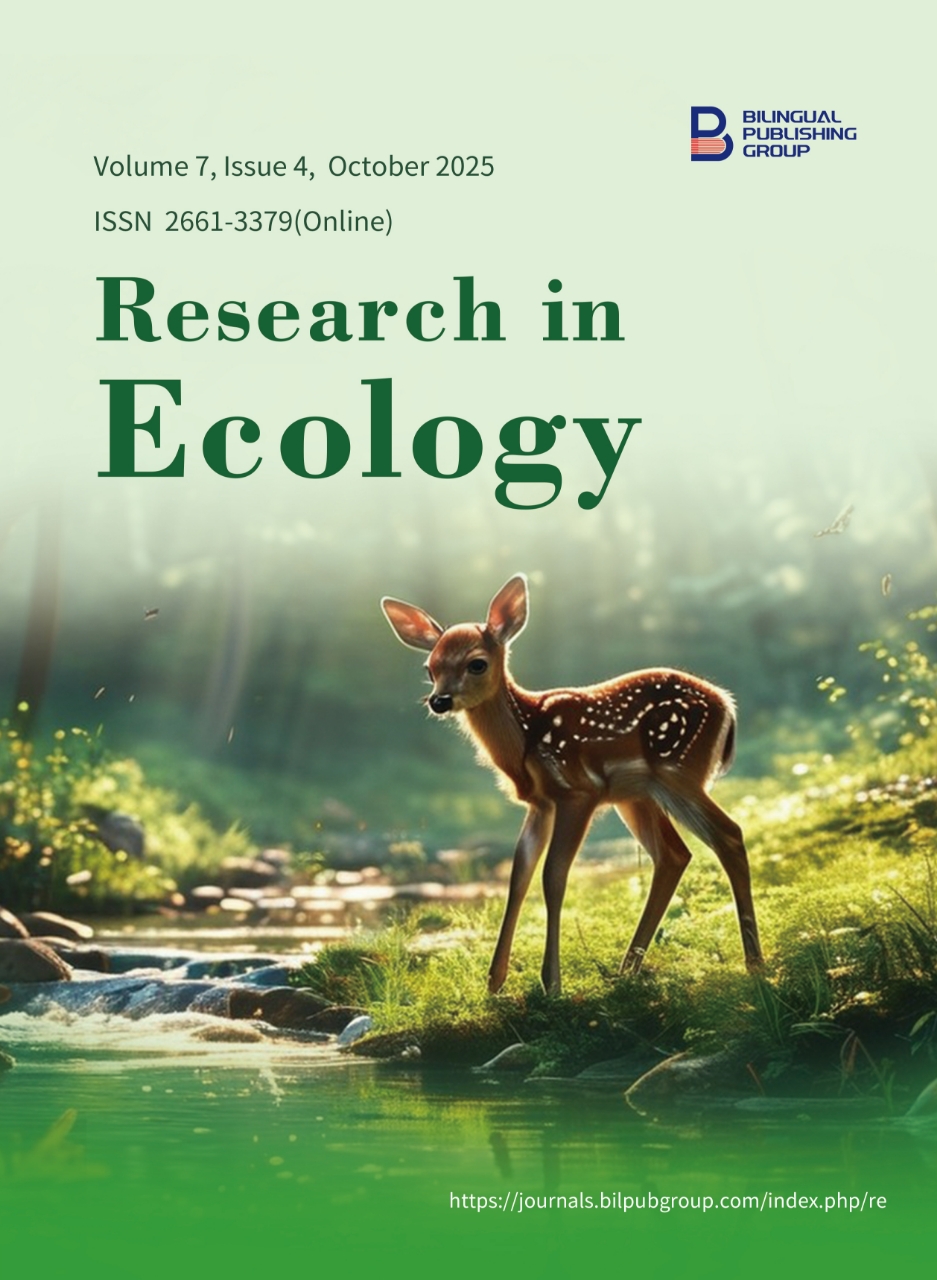
Environmental Factors and Their Relationship with Nitrogen Compounds in Walnut Tree (Carya illinoinensis)
DOI:
https://doi.org/10.30564/re.v7i4.10106Abstract
Total Soluble Proteins (TSP) and Total Amino Acids (TAA) help to tolerate adverse conditions in fruit trees. The objective of this research was to determine the influence of temperature and irradiation on the concentration of TSP and TAA in Carya illinoinensis trees. Pearson's correlation and multiple regression were made using mean temperature (°C) and irradiation (MJ·m2) data. The concentration of the TSP related to the temperature and irradiation in root, two correlation models were obtained, one for WN cultivar (F = 3.969, df = 2.9, P > 0.058, R2 = 0.469) and another one for the WA cultivar (F = 1.559, df = 2.9, P > 0.145, R = 0.507) where it was observed that the varieties have the same behavior in root for TSP. However, in the stem, the WA cultivar (R = 7.31, gl = 2.9, P < 0.013, R = 0.788) presented a greater mobility of TSP. In the case of WN cultivar, a lower mobility of TSP was observed (F = 2.407, gl = 2.9, P > 0.145, R = 5.90). In TAA, significant differences were observed in both cultivars: in WN cultivar, the correlation model was observed that at lower temperature and irradiation (F = 12.988, gl = 2.9, P < 0.002, R = 0.862), the concentration of TAA increases. In WA cultivar, it was found (F = 17.481, gl = 2.9, P < 0.01, R = 0.892) that lower temperature and irradiation decrease the concentration of TAA. The concentration of TAA in stem was significant in WN cultivar (F = 6040, df = 2.9, P < 0.022, R = 0.757) but not in WA cultivar (F = 2,602, df = 2.9, P > 0.128, R = 0.605). WN cultivar is the best adapted to climatic conditions in the region, due to its capacity to store an important reserve of nitrogen compounds.
Keywords:
Vegetative Reserves; Environmental Factors; Carya illinoinensis; N CycleReferences
[1] Briceño-Contreras, E.A., Moreno-Reséndez, A., Valenzuela-Núñez, L.M., et al., 2019. Influence of temperature and irradiation on starch concentration in Carya illinoinensis K. Koch varieties Wichita and Western. Revista Chapingo Serie Ciencias Forestales y del Ambiente. 25(3), 305–314. DOI: https://doi.org/10.5154/r.rchscfa.2018.12.089
[2] Orona-Castillo, I., Sangerman-Jarquín, D.M., Cervantes-Vázquez, M.G., et al., 2019. The production and commercialization of pecan nut in Mexico. Revista Mexicana de Ciencias Agrícolas. 10(8), 1797–1808.
[3] SIAP, 2022. Statistical Yearbook of National Agricultural Production by Crop in Perennial Cycles 2022 Irrigation-Temporary Modality. Available from: https://www.gob.mx/cms/uploads/attachment/file/723488/Expectativas_Agroalimentarias_2022.pdf (cited 25 February 2025). (in Spanish)
[4] Medina, M.C., Cano, C., 2002. General aspects of the pecan tree. In: Salinas, H.M., Quiroga, A., Tijerina, U.F. (eds.). Pecan Production Technology, 1st ed. Instituto Nacional de Investigaciones Forestales: México, Mexico. pp. 1–14. (in Spanish)
[5] Yepes, A., Buckeridge, M.S., 2011. Plant responses to environmental factors of global climate change. Review. Colombia Foresta. 14(2), 213–232. (in Spanish)
[6] Harfouche, A., Meilan, R., Altman, A., 2014. Molecular and physiological responses to abiotic stress in forest trees and their relevance to tree improvement Antoine. Tree Physiology. 34(11), 1181–1198. DOI: https://doi.org/10.1093/treephys/tpu012
[7] Li, S., Chen, H., Yu, H., et al., 2023. Responses and adaptations of fruit trees to high temperatures. Fruit Research. 3(1), 1–10.
[8] Jiménez, G.G., Ávila, J.A., Calzada, R.T., et al., 2006. Effect of photosynthetic radiation levels on biomass production in pecan trees. [Carya illinoinensis (Wangenh.) K. Koch]. Revista Chapingo Serie Zonas Áridas. 2, 179–184. (in Spanish)
[9] Chapin, F.S., Schulze, E.D., Mooney, H.A., 1990. The ecology and economics of storage in plants. Annual Review of Ecology and Systematics. 21, 423–447. DOI: https://doi.org/10.1146/annurev.es.21.110190.002231
[10] Millard, P., Grelet, G.A., 2010. Nitrogen storage and remobilization by trees: ecophysiological relevance in a changing world. Tree Physiology. 30(9), 1083–1095. DOI: https://doi.org/10.1093/treephys/tpq042
[11] Espino-Castillo, D.A., Valenzuela-Núñez, L.M., Legaria-Solano, J.P., et al., 2018. Evidence of a 20 kDa vegetative reserve protein in walnut root (Carya illinoinensis) during the dormant stage. Ecosistemas y Recursos Agropecuarios. 5(14), 309–317. (in Spanish)
[12] Valenzuela-Núñez, L.M., Gérant, D., Maillard, P., et al., 2011. Evidence for a 26kDa vegetative storage protein in the stem sapwood of mature pedunculate oak. Interciencia. 36(2), 142–147.
[13] Bradford, M.M., 1976. A rapid and sensitive method for the quantitation of microgram quantities of protein utilizing the principle of protein-dye binding. Analytical Biochemistry. 72(1–2), 248–254. DOI: https://doi.org/10.1016/0003-2697(76)90527-3
[14] Yem, E.W., Cocking, E.C., 1955. The determination of amino-acids with ninhydrin. Analyst. 80(948), 209–214. DOI: https://doi.org/10.1039/AN9558000209
[15] Bonhomme, R., 1993. The solar radiation: characterization and distribution in the canopy. In: Varlet-Grancher, C., Bonhomme, R., Sinoquet, H. (eds.). Crop structure and light microclimate: Characterization and applications. INRA Editions: Paris, France. pp. 17–28.
[16] Melke, A., 2015. The Physiology of Chilling Temperature Requirements for Dormancy Release and Bud-break in Temperate Fruit Trees Grown at Mild Winter Tropical Climate. Journal of Plant Studies. 4(2), 110–156. DOI: https://doi.org/10.5539/jps.v4n2p110
[17] Fujiwara, T., Nambara, E., Yamagish, K., et al., 2002. Storage protein. The Arabidopsis Book. 1, e0020. DOI: https://doi.org/10.1199/tab.0020
[18] Barbaroux, C., Bréda, N., Dufrêne, E., 2003. Distribution of above-ground and below-ground carbohydrate reserves in adult trees of two contrasting broad-leaved species (Quercus petraea and Fagus sylvatica). New Phytologist. 157(3), 605–615. DOI: https://doi.org/10.1046/j.1469-8137.2003.00681.x
[19] Mauk, C.S., 1987. Physiological effects of temperature and growth regulators on foliar chlorophyll, soluble protein, and cold hardiness in Citrus. Plant Growth Regulation. 5(2), 141–154.
[20] Sedaghat, S., Gaaliche, B., Rahemi, M., et al., 2022. Enzymatic activity and physico-chemical changes of terminal bud in rain-fed fig (Ficus carica L. 'Sabz') during dormant season. Horticultural Plant Journal. 8(2), 195–204. DOI: https://doi.org/10.1016/j.hpj.2021.03.010
[21] Eris, A., Gulen, H., Barut, E., et al., 2007. Annual patterns of total soluble sugars and proteins related to coldhardiness in olive (Olea). The Journal of Horticultural Science and Biotechnology. 82(4), 597–604. DOI: https://doi.org/10.1080/14620316.2007.11512279
[22] Binnie, S.C., Grossnickle, S.C., Roberts, D.R., 1994. Fall acclimation patterns of interior spruce seedlings and their relationship to changes in vegetative storage proteins. Tree Physiology. 14(10), 1107–1120.
[23] Sauter, J.J., Cleve, B.V., 1994. Storage, mobilization and interrelations of starch, sugars, protein and fat in the ray storage tissue of poplar trees. Trees. 8(6), 297–304.
[24] Gilson, A., Barthes, L., Delpierre, N., et al., 2014. Seasonal changes in carbon and nitrogen compound concentrations in a Quercus petraea chronosequence. Tree Physiology. 34(7), 716–729. DOI: https://doi.org/10.1093/treephys/tpu060
[25] Bollmark, L., Sennerby-Forsse, L., Ericsson, T., 1999. Seasonal dynamics and effects of nitrogen supply rate on nitrogen and carbohydrate reserves in cutting-derived Salix viminalis plants. Canadian Journal of Forest Research. 29(1), 85–94. DOI: https://doi.org/10.1139/x98-183
[26] Tromp, J., 1983. Nutrient reserves in roots of fruit trees, in particular carbohydrates and nitrogen. Plant and Soil. 71(1), 401–413. DOI: https://doi.org/10.1007/BF02182682
[27] Malaguti, D., Millard, P., Wendler, R., et al., 2001. Translocation of amino acids in the xylem of apple (Malus domestica Borkh.) trees in spring as a consequence of both N remobilization and root uptake. Journal of Experimental Botany. 52(361), 1665–1671. DOI: https://doi.org/10.1093/jxb/52.361.1665
[28] Canton, F.R., Suárez, M.F., Canovas, F.M., 2005. Molecular aspects of nitrogen mobilization and recycling in trees. Photosynthesis Research. 83(2), 265–278.
[29] Bazot, S., Barthes, L., Blanot, D., Fresneau, C., 2013. Distribution of non-structural nitrogen and carbohydrate compounds in mature oak trees in a temperate forest at four key phenological stages. Trees. 27(4), 1023–1034. DOI: https://doi.org/10.1007/s00468-013-0853-5
[30] Cheng, L., Fengwang, M., Ranwala, D., 2004. Nitrogen storage and its interaction with carbohydrates of young apple trees in response to nitrogen supply. Tree Physiology. 24(1), 91–98. DOI: https://doi.org/10.1093/treephys/24.1.91
[31] Xiong, H., Ma, H., Hu, B., et al., 2021. Nitrogen fertilization stimulates nitrogen assimilation and modifies nitrogen partitioning in the spring shoot leaves of citrus (Citrus reticulata Blanco) trees. Journal of Plant Physiology. 267, 153–556.
[32] Millard, P., Wendler, R., Grassi, G., et al., 2006. Translocation of nitrogen in the xylem of field-grown cherry and poplar trees during remobilization. Tree Physiology. 26(4), 527–536.
[33] Näsholm, T., Ericsson, A., 1990. Seasonal changes in amino acids, protein and total nitrogen in needles of fertilized Scots pine trees. Tree Physiology. 6(3), 267–281.
[34] Alaudinova, E.V., Mironov, P.V., 2018. Free Amino Acids in Vegetative Organs of Picea obovata L. and Pinus sylvestris L. Journal of Bioorganic Chemistry. 44(7), 887–892. DOI: https://doi.org/10.1134/S1068162018070026
[35] Montero-Torres, J., 2022. Relationship between solar radiation and plant production: agro-productive plants. Revista de Investigación e Innovación Agropecuaria y de Recursos Naturales. 9(1), 48–62. (in Spanish)
[36] Chávez, E.J.J., González, L., Valenzuela, N., et al., 2009. Morphology, stomatal index and density in pecan seedlings grown under three levels of solar radiation. Agrofaz. 9(3), 85–90. (in Spanish)
[37] Raffo, M.D., Iglesias, N., 2004. Effect of photosynthetically active radiation interception and distribution on Fuji apple trees under four high-density training systems. Revista de Investigaciones Agropecuarias. 33(2), 29–42. (in Spanish)
[38] Glenn, D.M., Yuri, J.A., 2013. Photosynthetically active radiation (PAR)× ultraviolet radiation (UV) interacts to initiate solar injury in apple. Scientia Horticulturae. 162, 117–124. DOI: https://doi.org/10.1016/j.scienta.2013.07.037
[39] Auzmendi, I., Marsal, J., Girona, J., Lopez, G., 2013. Daily photosynthetic radiation use efficiency for apple and pear leaves: Seasonal changes and estimation of canopy net carbon exchange rate. European Journal of Agronomy. 51, 1–8. DOI: https://doi.org/10.1016/j.eja.2013.05.007
Downloads
How to Cite
Issue
Article Type
License
Copyright © 2025 José Nicolás García-Ramírez, Dalia Ivette Carrillo-Moreno, Luis Manuel Valenzuela-Núñez, Viridiana Contreras-Villarreal, Rubén López-Salazar, Edwin Amir Briceño-Contreras, Fernando Arellano Rodríguez

This is an open access article under the Creative Commons Attribution-NonCommercial 4.0 International (CC BY-NC 4.0) License.




 José Nicolás García-Ramírez
José Nicolás García-Ramírez






